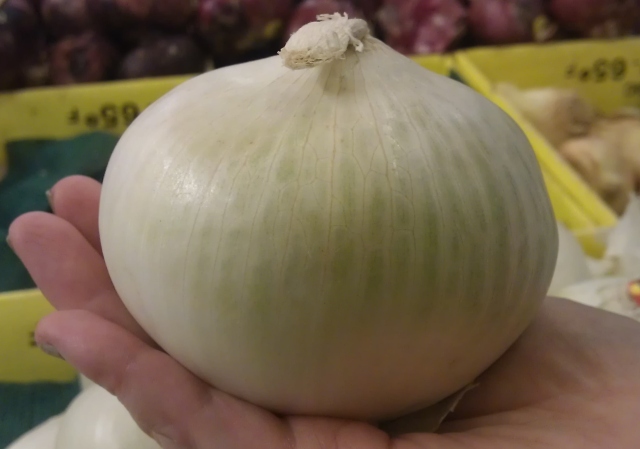 |
| Think Global: White Onion |
“Life is like an onion: you peel it off one layer at a time, and sometimes you weep.”
-Carl Sandburg, American historian, poet, and novelist (1878-1967)
“What? I can’t have layers?”
-Cordelia Chase, “Buffy the Vampire Slayer,” Season 3, Episode 6 (1998)
Back in the late fall, my cousin Marcia emailed me to confirm or deny a rampant belief that leftover onions were toxic and/or poisonous. (You may have seen the email about “Ed, the chemist” that warned millions of others about the same subject.) Now that summer is in full swing and many of us are enjoying onions in our potato salad and atop our grilled burgers, this bit of food folklore seemed an appropriate topic for this column, especially since Registered Dietitians (RDs) are trained in Food Safety.
This myth about the onion and the circulated email are not based in scientific fact. Onions (raw or otherwise) are no more at risk for bacterial contamination or spoilage than any other vegetable. Therefore it is not the onion itself, but how the onion is handled that presents the food safety risk: Are your hands dirty? Are you using a dirty cutting board or knife? Those handling methods will certainly increase contamination risks, regardless of food choice.
Find my full article on onions in OKRA Magazine here.
 |
Recommendations from this Registered Dietitian (RD):
-
Get layered. Caramelized onions are an optimal low-calorie flavor builder and alternative to mayo and spreads. Caramelize a red onion until it’s sweet and moist, and amp up your grilled burgers this summer. Use as a condiment and sandwich topping. No, onion rings don’t count!
-
Safety first. As with anything we consume, the need for Food Safety is consistent across all varieties of the onion family. This need increases when we consider that the onion is almost indispensable in cooking. The onion’s sugar content makes it useful in nearly all forms of cooking: baking, broiling, boiling, roasting, braising, frying, grilling, sautéing, steaming, or eating raw. Keep your Food Safety skills up-to-date.
-
No more tears. To reduce eye irritation during onion slicing, cut onions under running water or submerged in a basin of water. Consider refrigerating the onion before cutting to slow the enzymatic reaction rate and also reduce irritation.
-
Table the scraps. Onions can be toxic or deadly for pets and other animals. Do not feed your pets foods or leftovers containing onions, particularly pizza, onion rings, many canned foods, or Chinese food. Be diligent about putting leftovers away promptly and not leaving them out for your pets to sneak a nibble or two.
-
According to the Environmental Working Group, onions are one of the least-contaminated of pesticide-laden of fruits and vegetables. With such a wide variety of onions to be enjoyed raw or cooked, it will save some pennies when you don’t have to buy organic to avoid foods heavily-sprayed with pesticides.
-
Halitosis for health? Stronger tasting onions are associated with more superior health properties. For additional ways to excuse some of those pungent associations and more interesting information on onions, see the National Onion Association web site at http://www.onions-usa.org.
Onion lore has been rooted in both fact and fiction for
centuries. Considering the onion brings tears to your eyes and also
benefits your health, this contradiction makes some sense. While you
can’t believe everything you read online, the onion’s health properties
should not be similarly dismissed. Most people can improve their health
profiles by adding raw or cooked onions to their dietary intake. Any way
you slice it, that’s fine by me.